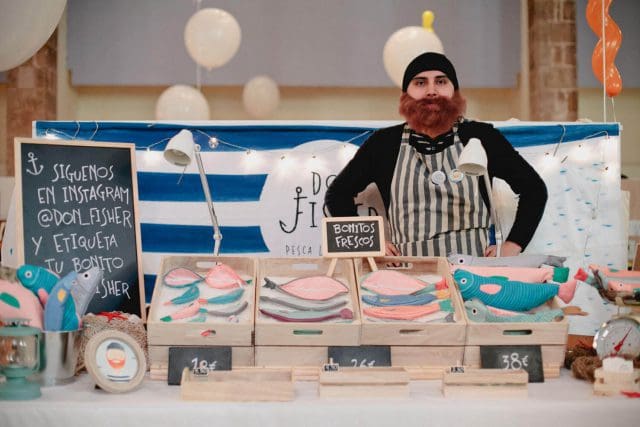3 Things Advanced Craft Show Displays Communicate
There are craft show tables that simply display products, and there are those that go above and beyond.
They create a full experience for shoppers.
As a shopper, you feel like you’re shopping with a legit business; you’re not just browsing a crafter’s creations.
Everything feels polished and thoughtful.
I think of these craft show displays as “advanced”.
Not every display needs to be “advanced”.
But if you can work one or more of these elements in, it will take your craft show display to the next level.
Below are three things a craft show display should communicate.
1) Brand
Some small businesses launch with a strong brand, while others develop a brand over time.
Regardless of whether you have a strong brand yet or not, you can make your space feel branded.
Think of your brand as a vibe.
What type of vibe do you want your craft show space to give?
Alternatively, you can think of it as the “mood” you want to create.
Think of one or two words you’d use to describe that vibe or mood.
For example:
- Calm
- Feminine
- Masculine
- Youthful
- Whimsical
- Vibrant
- Elegant
- Cozy
- Romantic
It may help to think of a well-known business you love. How might you describe the vibe of their stores, website, or advertisements?
You could also think about who might be your brand ambassador.
If you had millions of dollars to spend on marketing, which celebrity would you hire to represent your brand? And how might you describe that person’s vibe? Are they young and cool? An ageless beauty? Free-spirited? Rough and rugged?
Once you land on a word or two to describe your brand and the mood or vibe you want to communicate, think of how you can communicate it.
In a small craft show space, you may use:
- colors
- props
- packaging/tags
- display fixtures
- signage
- sounds
- words
- fonts
- smells
- etc.
For example, as a jewelry vendor, I may use the words “romantic” and “luxury” to describe my brand. Here’s how I might create a romantic and luxurious vibe in my space:
- colors – focus on black and white for a classic and luxurious feel. Alternatively, I could go with a soft pastel color pallet for a romantic vibe. I may also incorporate gold through signage frames and other props.
- props – flowers communicate “romance” so a beautiful vase full of fresh flowers would help communicate luxury and romance.
- packaging – I may wrap each sold product in crisp white tissue paper, seal it with a gold sticker, and place it into a black paper shopping bag. My prices would be printed (as opposed to hand-written) in black ink on a simple white sticker/tag.
- display fixtures – simple and high-end. I would purchase actual jewelry stands as opposed to trying to make household items work (i.e. no hanging necklaces from vases or hanging earrings from chicken wire).
- sounds – I could softly play classical music in my space if I had a full booth. If my space was smaller and it was a loud, busy event, my brand may be communicated through sound in the way I speak, which would be in a calm and formal manner.
- words – I would choose formal words for signage and when speaking. For example, I might call a collection that incorporates blue gems “the royal collection”.
- fonts – signage and tags would use a clean, classic font printed in black on a white background.
- smells – the smell of fresh flowers on the table would make people think of romance. I could also spritz my tablecloth with a subtle floral scent (scents should be light, natural, and subtle as some people are sensitive to strong and/or synthetic fragrances).
You can add as many or as few details as you want.
The more elements you layer, the stronger your brand’s message will be.
>> Read more about branding a craft show booth here: How To Brand a Craft Show Display Without a Logo
>> If you’re not sure what your brand is, start here: 3 (Easy) Steps to Define your Craft Business’s Brand
2) Story
The best displays help shoppers imagine themselves using your products.
If shoppers can’t imagine where, when, or how they’ll use an item or why they need it, it’s very unlikely they’ll buy it.
Think of your display’s story as the setting you want your target market to imagine.
Where will your products be used?
How can you get shoppers to imagine that setting?
If a particular setting isn’t ideal for your products, you may consider:
- how you want customers to feel when they use your products (e.g. a bath and body vendor may want customers to feel calm when using their products, so they would want shoppers to feel calm when in their craft show space).
- the inspiration behind your products (e.g. a vendor selling dog bandanas may share photos of dogs in their space or use signage explaining how a portion of each sale is donated to a local dog shelter. Their love of dogs is the inspiration behind their products).
- a benefit your products offer (e.g. a vendor’s products may help customers be more eco-friendly. The could incorporate natural elements into their display to help shoppers recognize that benefit).
You don’t have to go over the top to tell a story.
Through the use of props, colors, signage, etc. you can give shoppers a little nudge to get their minds going in the right direction.
However, you can go more literal and create a display that tells a detailed story.
This is one of my favorite craft show displays by a business selling handmade bags: Don Fisher ~ Fresh Fish Store. They make bags in the shape of fish and created a “fresh fish stand” at a craft show. Everything from the bed of ice the “fresh fish” are set on, to their signage and the fish vendor in an apron. The space tells the story of the inspiration behind their products (fish).

Here are a few more examples:
Travel Accessories
A display could tell the story of “travel” and help shoppers imagine when they might use the items.
A simple way to incorporate “travel” would be to use a suitcase as a prop. But one could keep building on that and suggest a popular travel destination, such as Paris, through the use of props. A craft show booth might have French music softly playing, a poster of the Eiffel Tower, a vintage camera as a prop, and the vendor may wear a beret.
You can go simple or extreme with your story. It depends on your brand, budget, space, and how creative you want to get.
Bath & Body products
A vendor selling bath and body products may want to create a bathroom-like setting. To keep it simple it may just be a few rolled up washcloths and a loofah. To go all-out, the vendor might use tiny bathtub props, add a pitcher and basin, and dress in a bathrobe.
A more extreme display may try to create a “calm” setting, through:
- soft blue and/or white for the tablecloth and display props
- battery powered candles
- spraying their tablecloth with a lavender essential oil spray (a lightly-scented one as some people have sensitivities to strong smells)
- adding a small electrical water fountain to the space (if there’s access to electricity)
- the vendor may wear a white shirt and beige bottoms and speak in a soft tone.
Jewelry
A vendor may have designed their jewelry to be worn by brides or at formal events such as weddings. A wedding setting could be suggested through:
- Soft colors, textures, and fabrics
- a bouquet of flowers
- signage that looks like name settings for tables
Again, these ideas won’t be a fit for every display or business. You can get creative or go as simple as you like.
3) Target Market
The most successful businesses, big and small, know who their customers are. And they’re not trying to appeal to everyone.
Think of your target market as the specific person you want to attract to your craft show table.
Consider: who are your products perfect for?
How might their friends describe them in one or two words, and as it relates to your products? Meaning “shy” would not be a good label if you’re selling soap because no one chooses their soap based on that character trait.
A target market is different from a brand in that you’re describing a person, rather than a vibe.
Who is your customer at their core?
There are many traits you can use to describe your customers, but I find it most helpful to find a common label (read more about labels here).
Examples of labels are:
- Foodie
- Tree hugger
- Spiritual
- Health Nut
- Fashionista
- Dog lover
- Sports fanatic
- Bride
- Mother
Finding a common label to describe your target market is a great place to start.
But there’s another really important aspect when it comes to choosing your target market.
I explain the key factor in How to Find a Goldmine of Customers. You’ll find it helpful if you don’t know who your target market is, or if you don’t know where to find them.*If you don’t know where to find your customers, you can’t sell to them.
When you know who your ideal customer is you can start to adjust every part of your business to appeal to them.
Such as:
- the types of events you sell at
- the products you display
- the colors/materials/ingredients/scents you choose for your products
- display colors and props that will catch their eye at an event
- your sales technique (does your ideal customer prefer a formal sales technique or a laid-back, helpful friend approach?
- how you dress (birds of a feather flock together so the right outfit/accessories/hairstyle/etc. can attract your perfect shopper)
- communication preference (do they prefer to stay in touch with you through TikTok or email?)
Put your customer first and consider what they want to see in a craft show display and how your display can speak to them.
If you’d like more advanced techniques, areas to think about, and examples, check out the free 5-day email course: 5 DAYS TO A STANDOUT CRAFT SHOW DISPLAY

Hey, I’m Erin 🙂 I write about small business and craft show techniques I’ve learned from being a small business owner for almost 2 decades, selling at dozens of craft shows, and earning a diploma in Visual Communication Design. I hope you find my advice helpful!
